Sight spots in Nara and Kyoto
Last week I went to some sightseeing spots in Kyoto and Nara, and I'm going to show you some photos I took:(Today I might be more instructive; if so, just see the pictures :))
 Daibutsu Pavillion of Todaiji Temple, Nara, about 35km(22mi.) south of Kyoto.
Daibutsu Pavillion of Todaiji Temple, Nara, about 35km(22mi.) south of Kyoto.Inside the pavillion is the Daibutsu, great image of Buddha, which is about 15m(16yd.) high.
 There are many deer around Todaiji Temple and nearby Kasuga Shrine; there deer is regarded as the sacred messenger of the shrine's deity and taken great care of.
There are many deer around Todaiji Temple and nearby Kasuga Shrine; there deer is regarded as the sacred messenger of the shrine's deity and taken great care of. Sanjusan-gen-do Temple in Kyoto.
Sanjusan-gen-do Temple in Kyoto.Sanjusan-gen-do literally means "33-spaced-temple," that is, this temple has thirty-four pillars on the east(left, in this picture) side of the hall. Quite a long temple building.
Inside it are 1,001 standing statues of Kannon Buddha, which create a magnificent and breath-taking view.
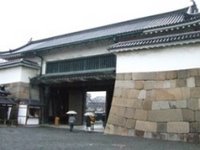
The main gate of Nijojo Castle, Kyoto.
The construction of the castle was launched by the first Tokugawa shogun(=a military commander in feudal Japan) Ieyasu in 1601, and Ieyasu's grandson Iemitsu, the third shogun, completed it later.
The total castle area is 275,000㎡(68As); the building area is 8,000㎡(2As).
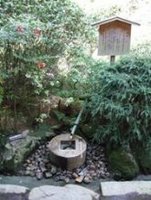 At Ryoanji Temple, Kyoto: the round stone below is tsukubai, a wash basin for a tea room, creating an atmosphere in harmony with sourrounding trees.
At Ryoanji Temple, Kyoto: the round stone below is tsukubai, a wash basin for a tea room, creating an atmosphere in harmony with sourrounding trees.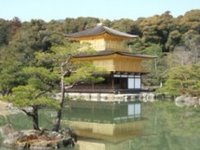 The Golden Pavillion of Kinkakuji (officially Rokuonji) Temple, Kyoto.
The Golden Pavillion of Kinkakuji (officially Rokuonji) Temple, Kyoto.The outer walls of 2nd and 3rd stories are put gold leaf over... so gorgeous!
In 1397 the third Ashikaga shogun Yoshimitsu renovated the temple to build the pavillion.
The pavillion was rebuilt in 1955, and in 1987 was the latest gold leaf-restamping.

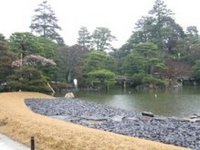
(Above) the gate to the main hall of the Old Imperial Palace in Kyoto
(Below) a pond garden there
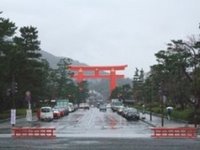

(Above) the red torii (=a gateway with 2 posts & crosspieces) to Heian Shrine, Kyoto
(Below) the main hall of the shrine
 (the left red one) The main gate of Kiyomizu Temple, which is one of the most famous Kyoto temples.
(the left red one) The main gate of Kiyomizu Temple, which is one of the most famous Kyoto temples.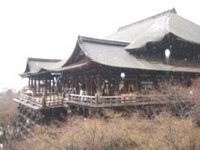
The most popular spot in this temple is "the platform stage of Kiyomizu."
The original temple is said to have been founded in late 8th century, and the halls including the stage were rebuilt in 1633 by Tokugawa shogun Iemitsu (I mentioned him at the part of Nijojo castle above).
What is remarkable about the stage is that it is built on a cliff, supported with 139 pillars, being used no nails.
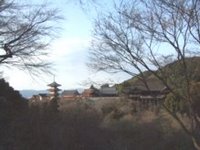 A distant view of Kiyomizu Temple
A distant view of Kiyomizu Temple A view of Hokanji Temple's Yasaka-no-tou, five-storied pagoda.
A view of Hokanji Temple's Yasaka-no-tou, five-storied pagoda.That's all. Enjoyed them?
Of course, Japan has so many modern buildings, particularly in big cities. But if you would like to see antient architecture of Japanese temples and shrines, I recommend you visit Kyoto or Nara.
See you there someday! :)

0 Comments:
Post a Comment
<< Home